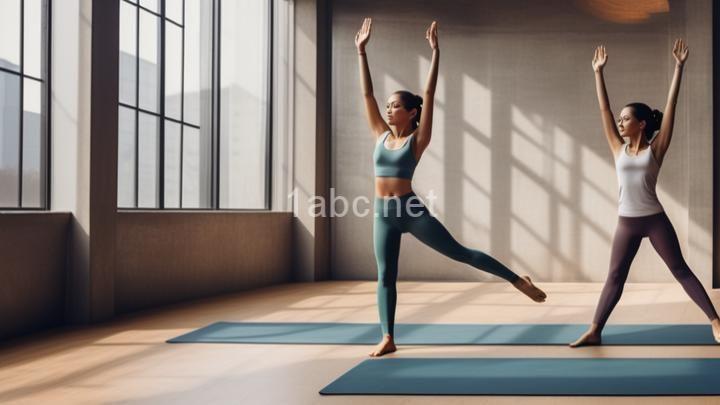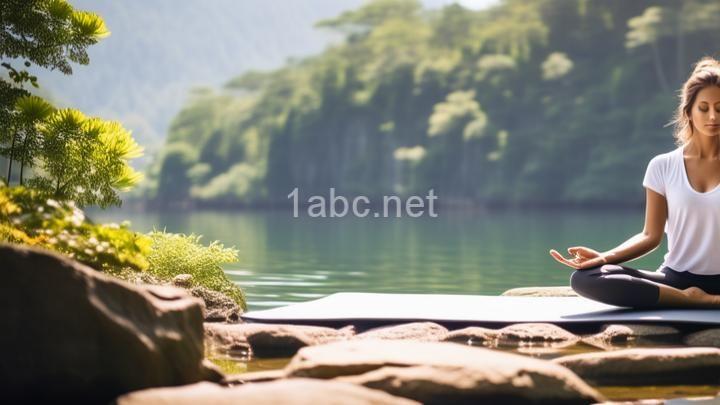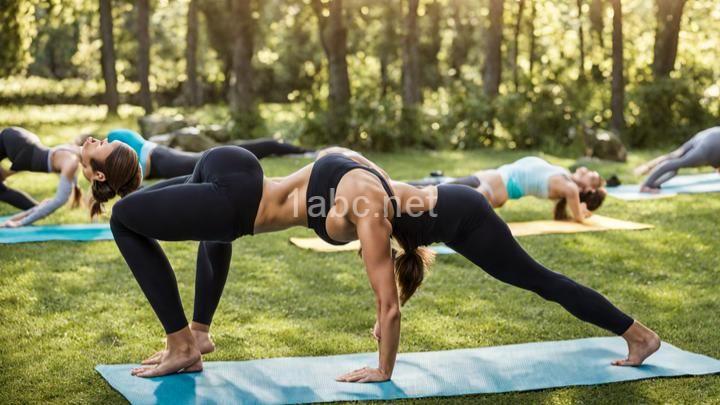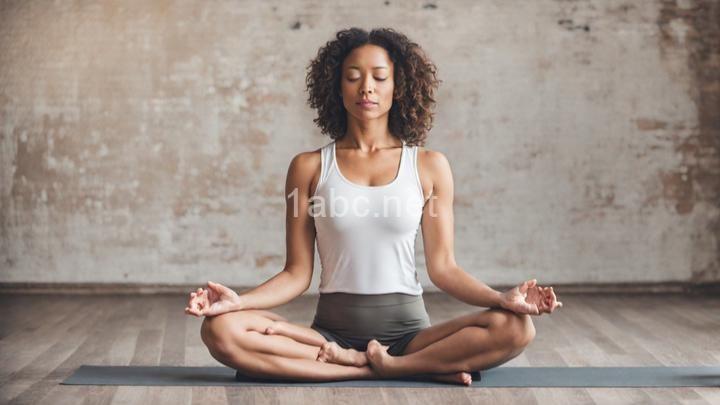Harnessing the Breath: Yoga Practices for Stress Relief and Mental Clarity

Welcome, dear readers! Take a moment to pause, take a deep breath, and let the stress of the day melt away. In today's blog post, we will delve into the world of yoga and explore how it can help us find relief from stress and achieve mental clarity. So, grab your yoga mat and let's dive in!
Yoga has been practiced for centuries, and one of its fundamental aspects is the breath. In yoga, conscious breathing is not just a means of getting oxygen into our bodies; it is a powerful tool that can transform our physical, mental, and emotional well-being. By becoming aware of our breath and learning to control it, we can tap into a wellspring of inner calm and clarity.
The benefits of deep, mindful breathing are truly remarkable. Studies have shown that practicing breathwork can reduce anxiety, lower blood pressure, and improve focus and concentration. It is a simple yet effective way to bring ourselves back to the present moment and find peace amidst the chaos of our daily lives.
Now, let's explore some simple breathing techniques that you can incorporate into your daily routine to relieve stress and find mental clarity.
1. Diaphragmatic Breathing:
- Sit or lie down in a comfortable position.
- Place one hand on your chest and the other on your belly.
- Take a deep breath in through your nose, allowing your belly to rise as you fill your lungs with air.
- Exhale slowly through your mouth, feeling your belly sink back down.
- Repeat this cycle of deep belly breaths for a few minutes, focusing on the sensation of the breath entering and leaving your body.
2. Equal-Length Inhale and Exhale:
- Find a comfortable seated position.
- Inhale slowly through your nose for a count of four.
- Exhale through your nose for a count of four.
- Continue this pattern of equal-length inhales and exhales, maintaining a steady rhythm.
- As you breathe, imagine that you are inhaling peace and exhaling stress.
3. Alternate Nostril Breathing:
- Close your right nostril with your right thumb.
- Inhale deeply through your left nostril.
- Close your left nostril with your ring finger.
- Exhale through your right nostril.
- Inhale through your right nostril.
- Close your right nostril and exhale through your left nostril.
- Repeat this pattern for several rounds, alternating between nostrils.
Now that you have mastered some simple breathing techniques, let's explore a few yoga poses that promote mental clarity and calmness.
1. Child's Pose (Balasana):
- Start by kneeling on the floor with your knees hip-width apart.
- Slowly lower your torso forward, resting your forehead on the mat.
- Extend your arms in front of you or alongside your body.
- Take slow, deep breaths, allowing your body to relax and surrender to the pose.
- Stay in this gentle posture for as long as feels comfortable, focusing on your breath and letting go of tension.
2. Standing Forward Fold (Uttanasana):
- Stand with your feet hip-width apart.
- Exhale as you hinge forward at the hips, folding your torso over your legs.
- Allow your head and neck to relax.
- Bend your knees slightly if necessary to maintain a gentle stretch in the hamstrings.
- Take deep breaths in this pose, feeling the release of tension in your neck and shoulders.
3. Corpse Pose (Savasana):
- Lie flat on your back, arms relaxed by your sides, palms facing up.
- Close your eyes and take slow, deep breaths.
- Allow your body to sink into the ground, releasing any tension or stress.
- Focus on the sensation of your breath flowing in and out of your body.
- Stay in this pose for at least a few minutes, allowing your mind to quiet and your body to rejuvenate.
Combining breathwork with movement is a powerful way to deepen your yoga practice and enhance mindfulness. Synchronizing your breath with yoga flows, such as Sun Salutations or Vinyasa flow, can help you find a state of flow and presence on the mat. Remember to link each movement with a corresponding inhale or exhale, allowing your breath to guide you through the practice.
But yoga is not just about what happens on the mat; it is a way of life. To truly cultivate mindfulness and find lasting stress relief, we must bring the practice into our everyday lives. Here are a few tips on how to do that:
- Practice mindful breathing during everyday activities, such as washing dishes or walking in nature.
- Set aside a few minutes each day for quiet reflection or meditation.
- Take breaks throughout the day to check in with your breath and bring yourself back to the present moment.
- Use reminders, such as a small object or a note on your phone, to prompt you to pause and take a deep breath whenever you feel stressed or overwhelmed.
Remember, dear readers, cultivating mindfulness and harnessing the power of your breath is a journey. Be patient with yourself and celebrate even the small moments of clarity and peace that you experience along the way. As you continue to explore the world of yoga and breathwork, you will discover new depths of serenity and find relief from stress that you never thought possible.
We hope this blog post has inspired you to embark on your own yoga journey and explore the incredible benefits of breathwork. If you have any questions or would like further resources, please feel free to reach out. We are here to support you on your path to wellness and mindfulness.
Thank you for joining us on this adventure, and until next time, breathe deeply and be well!
With warm regards,
dorenelashay9177
FREQUENTLY ASKED QUESTIONS
What is Harnessing the Breath: Yoga Practices for Stress Relief and Mental Clarity?
Harnessing the Breath: Yoga Practices for Stress Relief and Mental Clarity is a form of yoga that focuses on using the breath as a tool for managing stress and improving mental clarity. By paying attention to the breath and practicing specific breathing techniques, individuals can calm their minds, reduce anxiety, and enhance their overall well-being.In this practice, the breath is seen as a powerful source of energy and a bridge between the body and mind. By consciously controlling the breath, we can influence our state of mind and bring about a sense of calmness and clarity.
There are various techniques used in harnessing the breath, such as deep belly breathing, alternate nostril breathing, and breath retention. These techniques help activate the parasympathetic nervous system, which is responsible for promoting relaxation and reducing stress.
When practicing harnessing the breath, individuals are encouraged to find a quiet and comfortable space where they can sit or lie down. They are then guided to focus their attention on the breath, observing its natural rhythm and flow. Through gentle and intentional breathing exercises, they learn to deepen and lengthen their breath, bringing about a sense of relaxation and tranquility.
Regular practice of harnessing the breath can have numerous benefits. It can help reduce the physical symptoms of stress, such as rapid heartbeat and shallow breathing. It can also promote mental clarity and improve concentration, allowing individuals to better cope with the challenges of daily life.
In addition to stress relief and mental clarity, harnessing the breath can also help individuals cultivate mindfulness and increase self-awareness. By paying close attention to the breath, individuals develop a deeper connection with their bodies and become more attuned to their thoughts and emotions.
Overall, harnessing the breath is a valuable practice for anyone seeking stress relief and mental clarity. By incorporating these yoga techniques into their daily routine, individuals can experience a greater sense of calmness, focus, and overall well-being. So, why not give it a try and see the positive impact it can have on your life?
How can this program help me with stress relief?
Our program is designed to provide effective stress relief techniques and strategies to help individuals manage and reduce their stress levels. By participating in our program, you will have access to a variety of resources and tools that can assist you in understanding and coping with stress in a healthy and productive manner.Through our program, you will learn techniques such as deep breathing exercises, mindfulness meditation, and progressive muscle relaxation. These techniques have been shown to promote relaxation, reduce anxiety, and improve overall well-being. Additionally, our program also offers guidance on stress management strategies, such as time management and effective communication skills, which can help you better navigate stressful situations in your daily life.
One of the benefits of our program is its flexibility. You can access the program at your own convenience, allowing you to fit stress relief activities into your busy schedule. Whether you prefer to follow guided meditation sessions or read informative articles on stress management, our program offers a wide range of options to suit your preferences and needs.
Furthermore, our program takes a holistic approach to stress relief, addressing not only the physical aspects of stress but also the emotional and mental components. We understand that stress can manifest in different ways for different individuals, and our program aims to provide a comprehensive toolkit to help you find what works best for you.
It's important to note that while our program can be a valuable resource in managing stress, it is not a substitute for professional help. If you are experiencing severe or chronic stress, we recommend seeking support from a qualified healthcare professional or therapist.
In conclusion, our stress relief program offers a variety of techniques and strategies to help you effectively manage and reduce stress in your life. By incorporating these practices into your routine, you can experience improved well-being and a greater sense of calmness and balance.
Can anyone practice this program, or is it only for experienced yogis?
This program is designed to be accessible to individuals of all experience levels, whether you're a seasoned yogi or just starting out. It provides modifications and variations for each pose, allowing you to customize the practice to suit your abilities and needs. So, whether you're a beginner or an experienced practitioner, you can definitely benefit from this program.
How often should I practice the techniques in this program?
In order to see progress and improvement, consistency is key when practicing the techniques in this program. It is generally recommended to practice on a regular basis, ideally every day or at least a few times a week. However, the frequency of practice can vary depending on your personal schedule and commitments. It's important to find a balance that works for you, so you can stay motivated and avoid burnout. Remember, quality practice is just as important as quantity, so make sure to focus and give your full attention during each session. Happy practicing!



